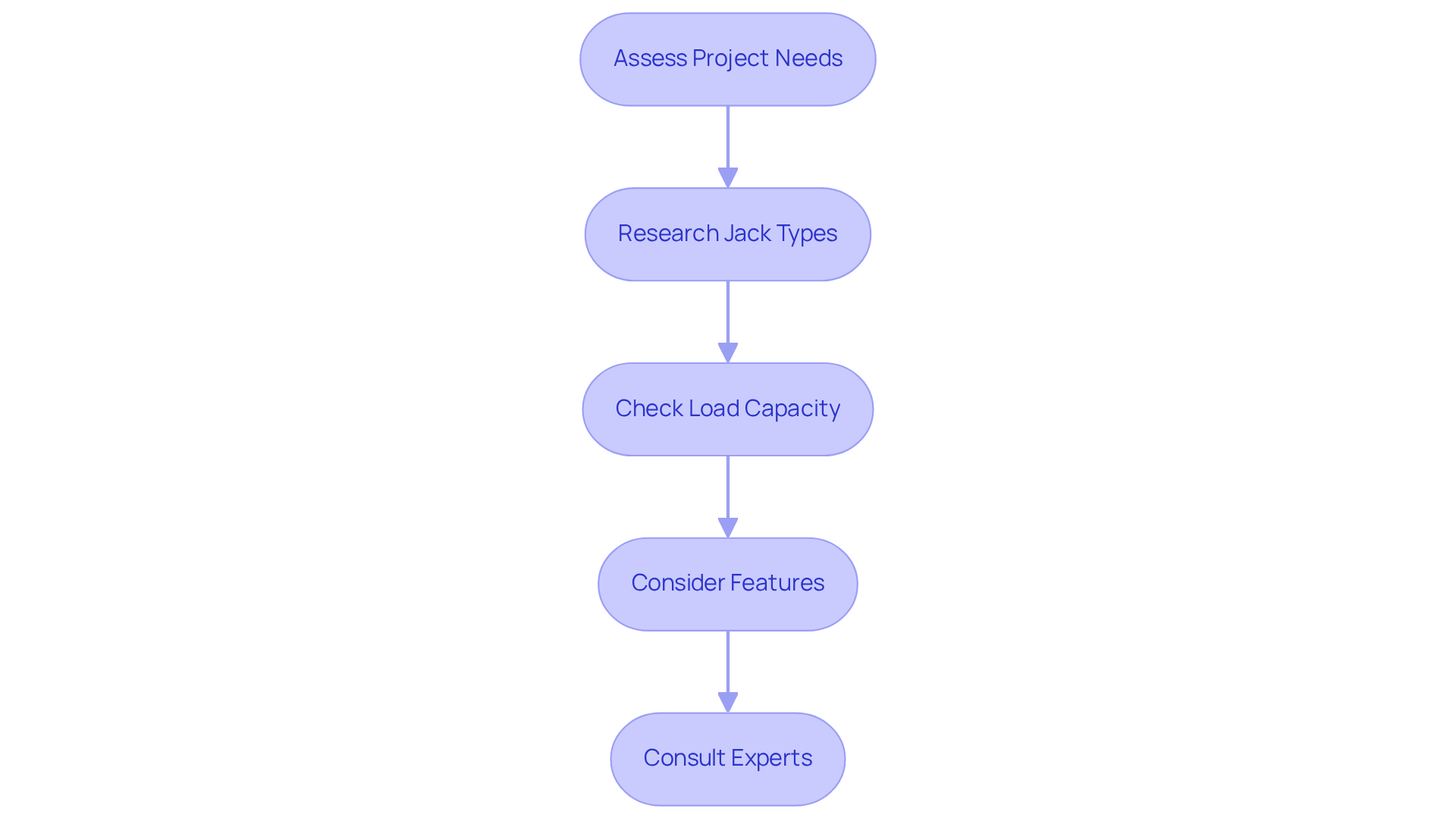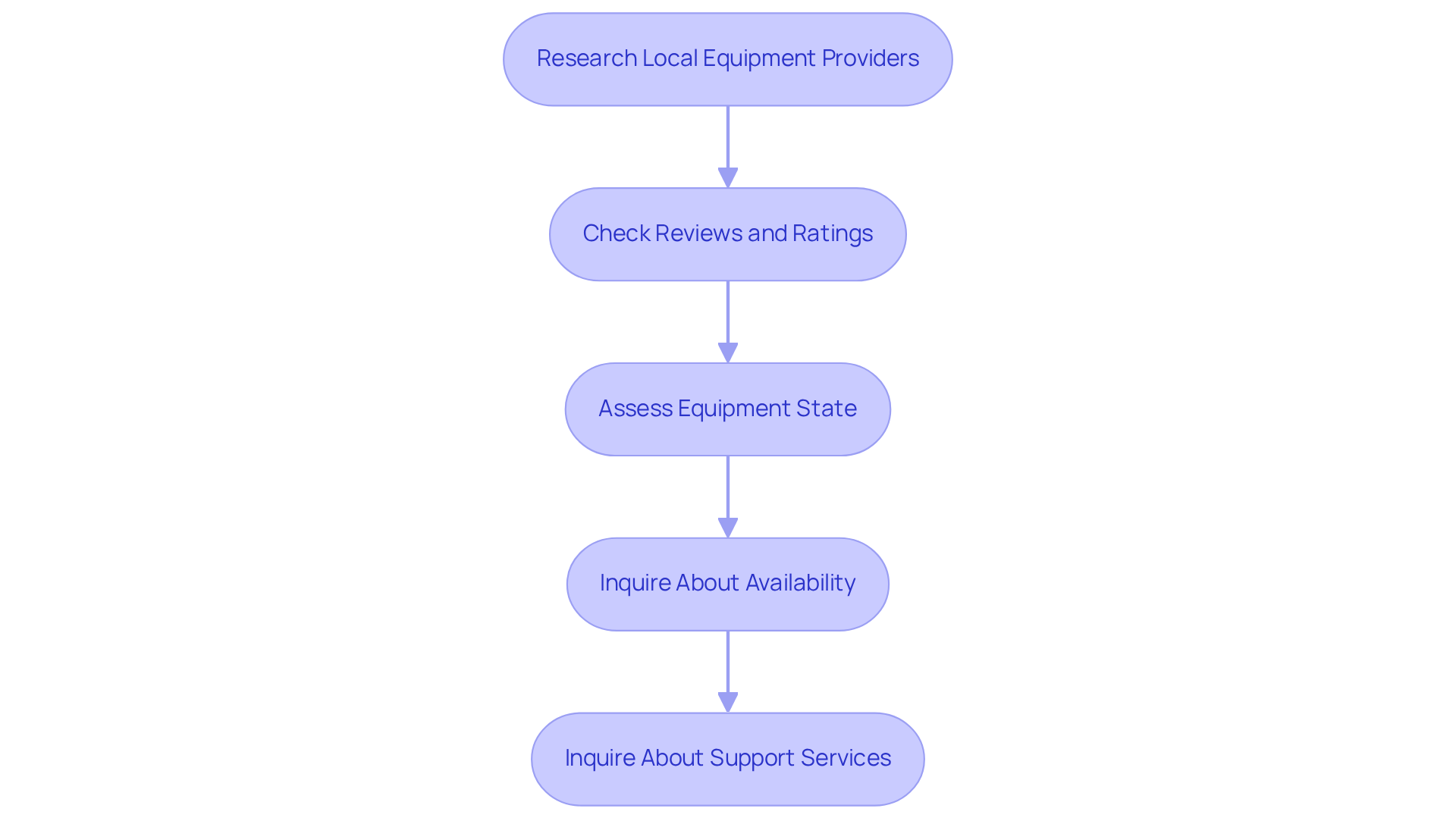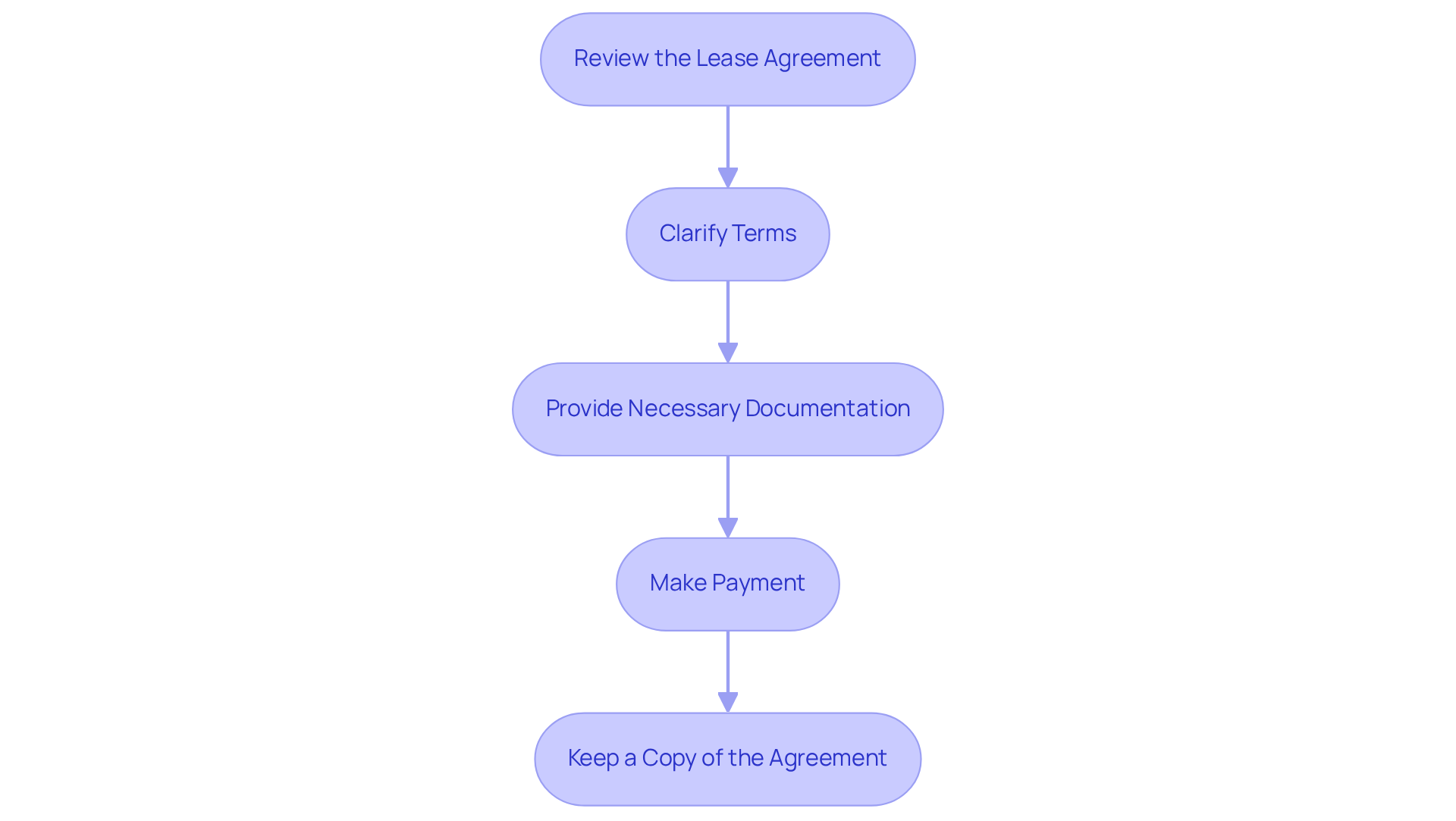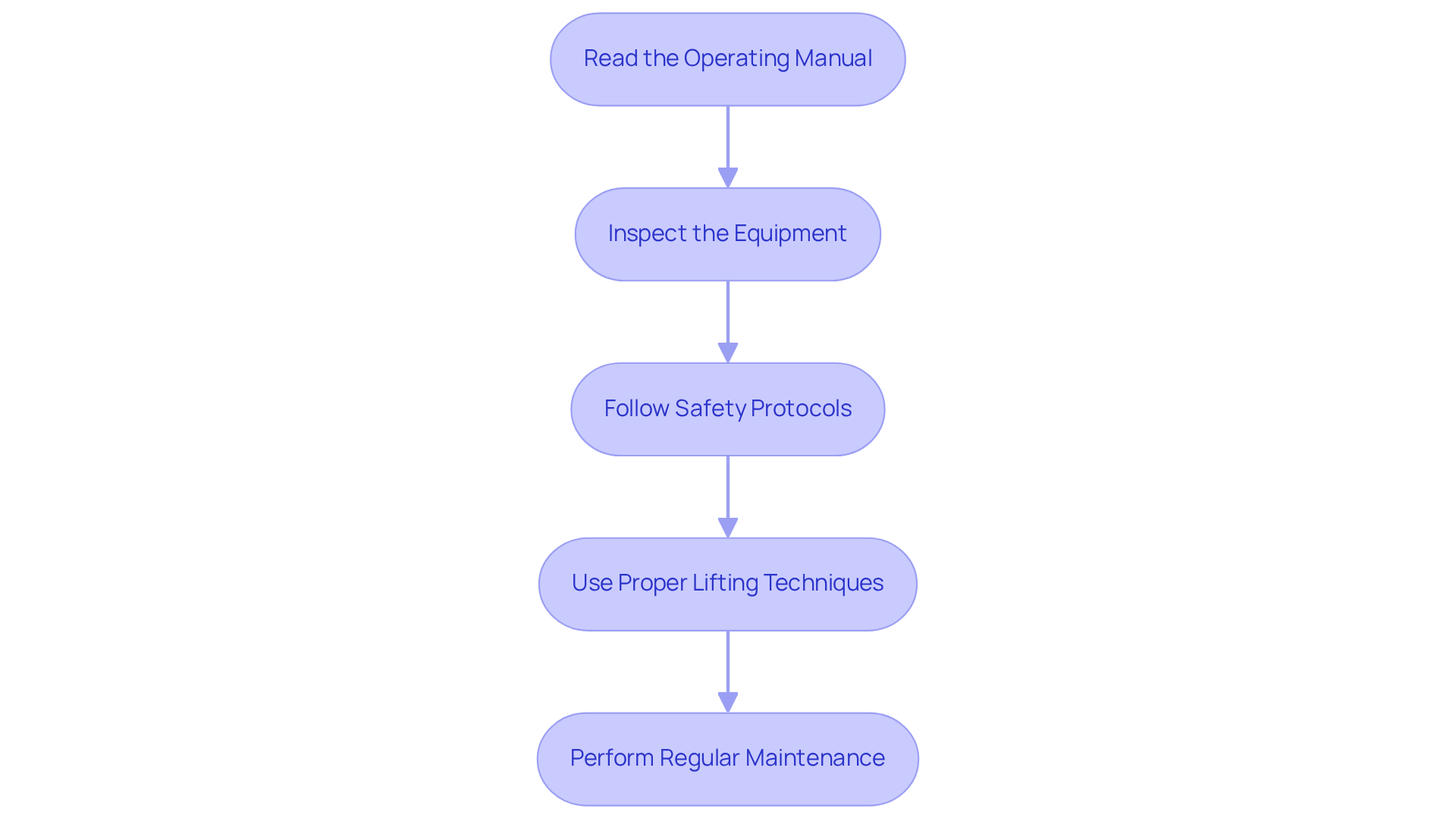Overview
The article delineates four essential steps for effective railroad jack rental management:
- Selecting the right equipment
- Locating reliable rental services
- Completing the rental agreement
- Ensuring safe operation and maintenance
Each step is bolstered by comprehensive guidelines, such as:
- Assessing load requirements
- Checking equipment reviews
- Understanding lease terms
- Adhering to safety protocols
These elements collectively guarantee the efficient and secure use of railroad jacks across various projects.
In selecting the right equipment, it is crucial to assess the load requirements accurately. This assessment ensures that the equipment can handle the specific demands of your project. Furthermore, checking equipment reviews provides insight into reliability and performance, allowing you to make informed decisions. By prioritizing quality equipment, you set the foundation for a successful rental experience.
Next, locating reliable rental services is paramount. Researching rental companies and reading customer testimonials can highlight their reputation and service quality. Engaging with reputable providers not only enhances reliability but also contributes to a smoother rental process. Additionally, understanding lease terms is essential for avoiding potential pitfalls and ensuring compliance with all agreements.
Completing the rental agreement with diligence is another vital step. Ensure that all terms are clearly understood and documented, as this minimizes misunderstandings and protects your interests. Finally, ensuring safe operation and maintenance is critical. Adhering to safety protocols not only safeguards personnel but also prolongs the life of the equipment. By following these steps, you can confidently engage in railroad jack rentals, ensuring both effectiveness and safety in your projects.
Key Highlights:
- Assess project needs by evaluating load weight, lift height, and environment.
- Familiarise yourself with different types of railroad jacks: hydraulic, mechanical, and toe types.
- Ensure the jack can handle the load capacity with a safety margin (e.g., 12 tonnes for a 10-tonne load).
- Consider features like adjustable height, stability, and safety mechanisms.
- Consult experts for tailored advice on equipment selection.
- Research local equipment rental providers, focusing on their expertise and service range.
- Cheque customer reviews to gauge reliability and service quality.
- Inquire about equipment maintenance history for safety and performance assurance.
- Confirm the availability of required equipment for your project schedule.
- Assess whether the rental service offers support services like delivery and training.
- Review the lease agreement carefully, clarifying any unclear terms before signing.
- Prepare necessary documentation for the leasing process to expedite it.
- Follow payment instructions as detailed in the lease agreement.
- Keep a copy of the lease agreement for reference throughout the rental period.
- Read the operating manual thoroughly before using the railroad jack.
- Conduct a pre-operation inspection to identify any potential issues.
- Adhere to safety protocols and wear appropriate personal protective equipment (PPE).
- Use proper lifting techniques to maintain control and ensure safety.
- Perform regular maintenance checks and report any issues to the rental company.
Introduction
Navigating the complexities of railroad jack rental management can be a daunting task for even the most seasoned professionals. However, with the right approach, it can lead to enhanced project efficiency and safety. This guide offers a structured pathway to effectively select, rent, and operate railroad jacks, ensuring that projects run smoothly and without costly delays. Understanding the critical steps that can make or break the success of a railroad jack rental is essential for achieving optimal results.
Identify the Right Railroad Jack for Your Project
-
Assess Your Project Needs: Start by evaluating the weight of the loads you will lift and the necessary lift height. Consider the environment—whether the work occurs indoors or outdoors—and any spatial constraints that may influence equipment placement.
-
Research railroad jack rental types: Become acquainted with the various types of railroad lifting devices, including hydraulic, mechanical, and toe types. Each type presents unique features designed for specific lifting tasks, making it essential to grasp their applications.
-
Check Load Capacity: Ensure that the device you choose can safely handle the maximum weight of your load, including a safety margin. For instance, if your load weighs 10 tons, select a lift with a minimum capacity of 12 tons to guarantee safe operation. Notably, Whiting portable electric rail lifters are available in capacities of 25, 50, and 60 tons, providing options for diverse lifting needs.
-
Consider Features: Assess critical features such as adjustable height, stability, and ease of use. Look for lifts equipped with security locks and overload protection, which are vital for safety during lifting tasks. Whiting's devices, for example, feature a self-locking design that enhances security and reliability.
-
Consult with Experts: If uncertain, seek advice from tool leasing specialists or experienced project managers. Their expertise can assist you in selecting the most appropriate jack tailored to your project requirements, ensuring optimal performance and safety. As Phillip Eng, president of the LIRR, stated, the right technology can significantly influence project outcomes, underscoring the importance of expert consultation.

Locate a Reliable Equipment Rental Service
-
Research Local Equipment Providers: Begin by identifying machinery leasing services in the Dallas-Fort Worth area. For instance, EZ Equipment Rental in Irving, TX, specializes in a diverse range of machinery, including boom lifts, excavators, and forklifts. This targeted approach ensures you connect with providers who possess the necessary expertise.
-
Check Reviews and Ratings: Investigate customer feedback and ratings across various platforms to evaluate the reliability and quality of service offered by these leasing companies. Positive feedback is often indicative of a strong track record in customer satisfaction—an essential factor in the leasing sector. Notably, 62% of respondents in 2022 cited adaptability in returning items as their primary reason for leasing, underscoring the importance of customer satisfaction in this process.
-
Assess Equipment State: Reach out to prospective leasing services, such as EZ Equipment Rental, to inquire about the status and maintenance history of their machinery. Well-maintained equipment not only enhances safety but also guarantees optimal performance during your project. The U.S. construction machinery leasing market was valued at USD 39.2 billion in 2022, emphasizing the significance of quality tools in this competitive landscape.
-
Inquire About Availability: Confirm that the service provides the specific type of equipment you require for your project schedule. Availability can significantly impact your timeline, making it essential to clarify this detail upfront.
-
Inquire About Support Services: Assess whether the company offers additional support services, such as delivery, setup, and operator training. EZ Equipment Rental provides these services, greatly facilitating your project and enhancing overall efficiency. As the market is projected to grow at a CAGR of 4.73% from 2022 to 2029, having reliable support can be a crucial factor in your project's success.

Complete the Rental Agreement and Payment Process
-
Review the Lease Agreement: Thoroughly examine the lease agreement, focusing on key aspects such as lease duration, payment schedules, and responsibilities for maintenance and damages. Understanding these elements is crucial to avoid misunderstandings later. Additionally, consider how railroad jack rental from EZ Equipment Rental can streamline your operations and save costs.
-
Clarify Terms: If any terms are unclear, proactively seek clarification from the leasing company before signing. Ensure you fully comprehend your obligations and the company's policies to prevent potential disputes. As legal expert Lynnette Jimenez states, "Clear terms are essential to prevent misunderstandings that can lead to disputes."
-
Provide Necessary Documentation: Be prepared to submit required paperwork, including identification, proof of insurance, and any other specified materials to complete the leasing process. This preparation can expedite your leasing experience and is crucial in a market projected to grow to $78 billion by 2025.
-
Make Payment: Adhere to the payment instructions detailed in the agreement. This generally includes a deposit, usage fees, and any extra costs for late returns or damages. Comprehending the payment arrangement aids in financial planning for the lease. Remember, railroad jack rental can provide a cost-effective solution for your projects, allowing you to allocate resources more efficiently.
-
Keep a Copy of the Agreement: After signing, retain a copy of the lease agreement for your records. This document will serve as a reference throughout the leasing period, ensuring you can address any issues that may arise. The knowledgeable team at EZ Equipment Rental is available to assist you throughout this process, ensuring a smooth experience and helping you leverage the advantages of railroad jack rental for your construction needs.

Operate and Maintain the Railroad Jack Safely
-
Read the operating manual: Prior to utilizing the railroad jack rental, it is imperative to thoroughly review the operating manual provided by the rental company. This essential document outlines the jack's features, operational guidelines, and protocols critical for secure usage.
-
Inspect the Equipment: Conducting a pre-operation inspection is vital. Check for visible damage, leaks, or wear, and ensure all components function correctly. This step aids in identifying potential issues that could compromise safety during operation. As industry experts emphasize, "Regular inspections are crucial for avoiding incidents and ensuring machinery dependability."
-
Follow Safety Protocols: Adhering to established safety guidelines is non-negotiable. Always wear appropriate personal protective gear (PPE) and ensure the work area is free of hazards. This proactive approach significantly minimizes risks associated with equipment operation. Notably, on-duty fatalities for railroads have decreased by 27% since 2005, underscoring the necessity for stringent protective measures.
-
Use Proper Lifting Techniques: Position the device correctly under the load and operate it slowly and steadily. Avoid sudden movements that could lead to accidents. Proper lifting techniques are essential for maintaining control and ensuring safety during operation.
-
Perform Regular Maintenance: After each use, clean the device and check for maintenance needs, such as oil levels or hydraulic fluid. Common issues reported for railroad jack rental include hydraulic leaks and worn components. Promptly report any issues to the rental company to ensure safe operation for future users. Regular maintenance not only helps prevent these common problems but also enhances the longevity of the equipment.

Conclusion
Effectively selecting and managing railroad jack rentals requires a structured approach that prioritizes safety, reliability, and efficiency throughout your project. By adhering to the outlined steps—from identifying the right equipment to comprehending the rental agreement and maintaining the jack—project managers can optimize operations and mitigate risks.
- Assessing project needs is essential, as is researching various jack types and consulting with experts to make well-informed decisions.
- Furthermore, partnering with a reputable equipment rental service and ensuring clear communication regarding rental terms can significantly enhance the overall experience.
- Regular inspections and strict adherence to safety protocols are vital for maintaining operational integrity and preventing accidents during use.
Ultimately, proficient management of railroad jack rentals not only drives project success but also underscores the significance of safety and reliability in construction operations. By prioritizing these critical aspects, project managers can leverage the advantages of rental equipment while ensuring the seamless execution of their projects. Embrace these practices to cultivate a safer, more efficient work environment and achieve successful project outcomes.
Frequently Asked Questions
How do I assess my project needs when selecting a railroad jack?
Start by evaluating the weight of the loads you will lift and the necessary lift height. Consider the environment where the work will take place, whether indoors or outdoors, and any spatial constraints that may affect equipment placement.
What types of railroad jacks are available for rental?
There are various types of railroad lifting devices, including hydraulic, mechanical, and toe types. Each type has unique features designed for specific lifting tasks, so it’s important to understand their applications.
How do I determine the load capacity needed for a railroad jack?
Ensure that the device can safely handle the maximum weight of your load, including a safety margin. For instance, if your load weighs 10 tons, select a lift with a minimum capacity of 12 tons. Whiting portable electric rail lifters, for example, are available in capacities of 25, 50, and 60 tons.
What features should I consider when choosing a railroad jack?
Assess critical features such as adjustable height, stability, and ease of use. Look for lifts with security locks and overload protection, which are essential for safety. Whiting's devices, for instance, have a self-locking design that enhances security and reliability.
Should I consult with experts before selecting a railroad jack?
Yes, if you are uncertain, it's advisable to seek advice from tool leasing specialists or experienced project managers. Their expertise can help you choose the most appropriate jack for your project requirements, ensuring optimal performance and safety.




